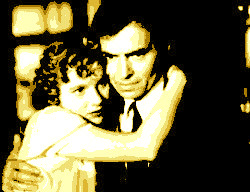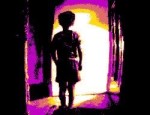Film Review

Adapted from a popular novel by Libbie Block Caught takes the classic rags-to-riches scenario and twists it into something that drips with dark cynicism, a cruel morality play wrapped around a slick melodrama, cautioning us that wealth and power lead only to misery and isolation. Ryan's Ohlrig may be a monster but he is one that we cannot help sympathising with. Unlike the other protagonists (played with striking realism by two other fine performers, James Mason and Barbara Bel Geddes), he has no way out of his private Hell and is destined to live in bitter solitude, slowly eaten away by his paranoid delusions.
Less creatively constrained than he would be on his subsequent film noir The Reckless Moment (1949), Ophüls brings a visual flair to Caught that presages his work on his subsequent French masterpieces. In several scenes, long tracking shots are employed in which the camera seems to glide with a balletic nonchalance, bringing a romantic touch that effectively counterpoints the menacing brutality of Lee Garmes's harsh lighting in other scenes. This heightens the sense of conflict we perceive between the heroine's dream world, all velvet and satin, and the less glamorous reality in which she becomes trapped. Barbara Bel Geddes's understated performance adds to her character's vulnerability and makes her the most tragic of film noir heroines, a naive young woman whose American dream soon becomes the most harrowing of nightmares. Max Ophüls's most scathing piece of social commentary is also one of his most perceptive films, one that leaves a very sour aftertaste and remains frighteningly pertinent to this day.
© James Travers 2014
The above content is owned by frenchfilms.org and must not be copied.
Film Synopsis
Working class girl Leonora Eames decides to improve her marital prospects by attending a charm school. She pays for her fees by working as a model, which earns her an invitation from a rich client to attend a yachting party. On the way to the party, she runs into a stranger who offers to ferry her to the yacht. The man turns out to be Smith Ohlrig, a millionaire businessman. Having seen Leonora a couple of times after this, Ohlrig decides to marry her, knowing that she is a golddigger. The marriage soon proves to be a disaster and Leonora becomes so fed up with her husband's ill treatment of her that she decides to leave him. She swaps her luxury Long Island residence for a cramped apartment in a poor district of New York, where she finds work as a secretarial assistant to Dr Larry Quinada at a medical clinic for the city's poor. In no time, Leonora and Larry fall in love, but Ohlrig has no intention of letting his wife go without a fight. When he learns that Leonora is pregnant, the tycoon agrees to a divorce, but only if she is willing to give him custody of their child...© James Travers
The above content is owned by frenchfilms.org and must not be copied.
Similar Films
Here are some other films you may enjoy watching:- Le Garçon sauvage (1951)
- Great Expectations (1946)
- La Vérité sur Bébé Donge (1952)
- The Ugly American (1963)
- Les Roquevillard (1943)
Other related links:
Film Credits
- Director: Max Ophüls
- Script: Arthur Laurents, Libbie Block (novel)
- Cinematographer: Lee Garmes
- Music: Friedrich Hollaender
- Cast: James Mason (Larry Quinada), Barbara Bel Geddes (Leonora Eames), Robert Ryan (Smith Ohlrig), Frank Ferguson (Dr. Hoffman), Curt Bois (Franzi Kartos), Ruth Brady (Maxine), Natalie Schafer (Dorothy Dale), Art Smith (Psychiatrist), Barbara Billingsley (Store customer in flowered hat), Ralph Brooks (Businessman), Wheaton Chambers (Servant), Dorothy Christy (Wealthy Shopper), Sonia Darrin (Miss Chambers), Wilton Graff (Gentry), Ilka Grüning (Grandmother Rudetzki), Jimmy Hawkins (Kevin), Bernadene Hayes (Mrs. Rudecki), Robert Haynes (Butler), Virginia Hunter (Lushola), Robert Hyatt (Little Boy)
- Country: USA
- Language: English
- Support: Black and White
- Runtime: 88 min
The brighter side of Franz Kafka

The very best sci-fi movies

The history of French cinema
